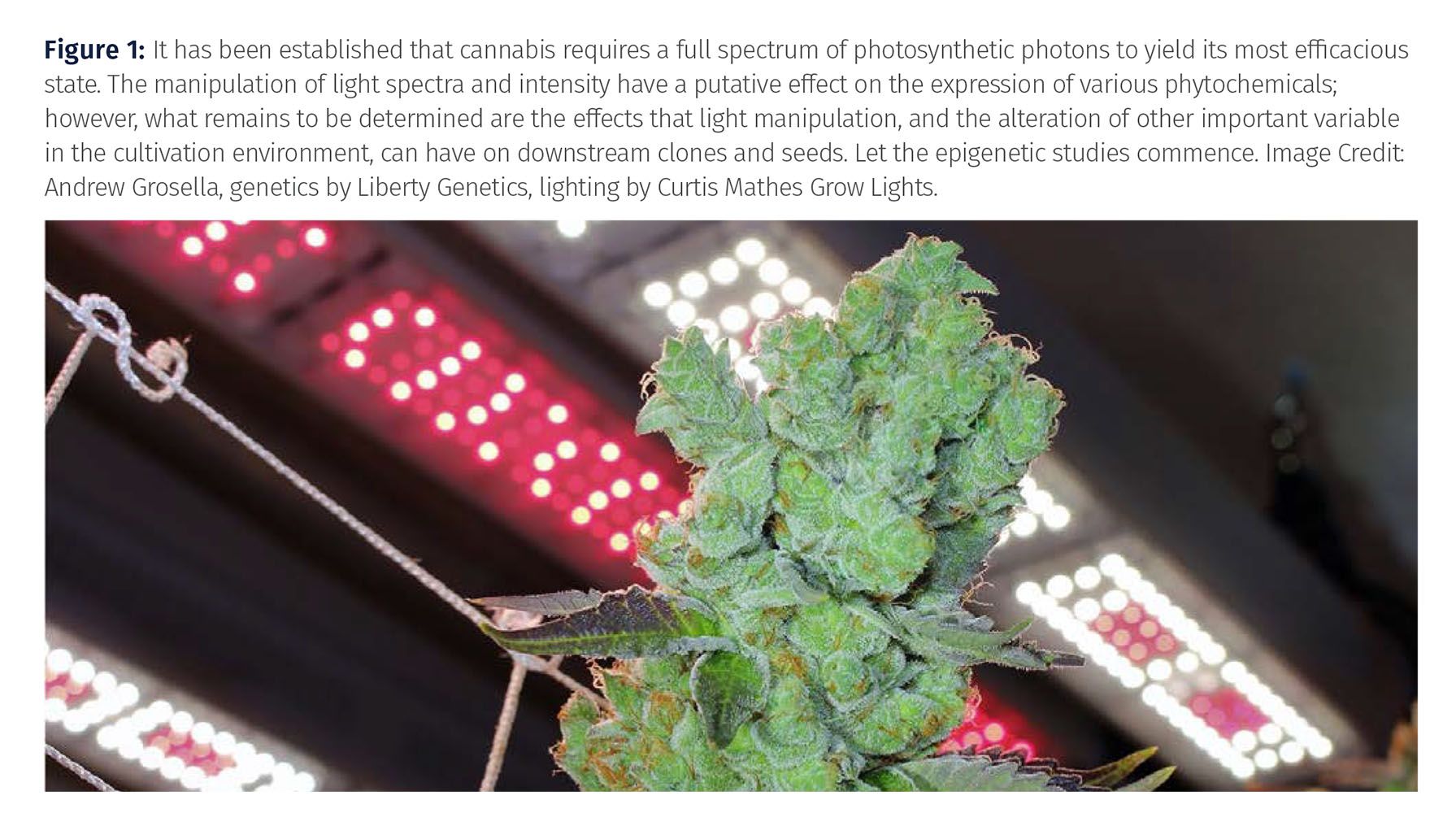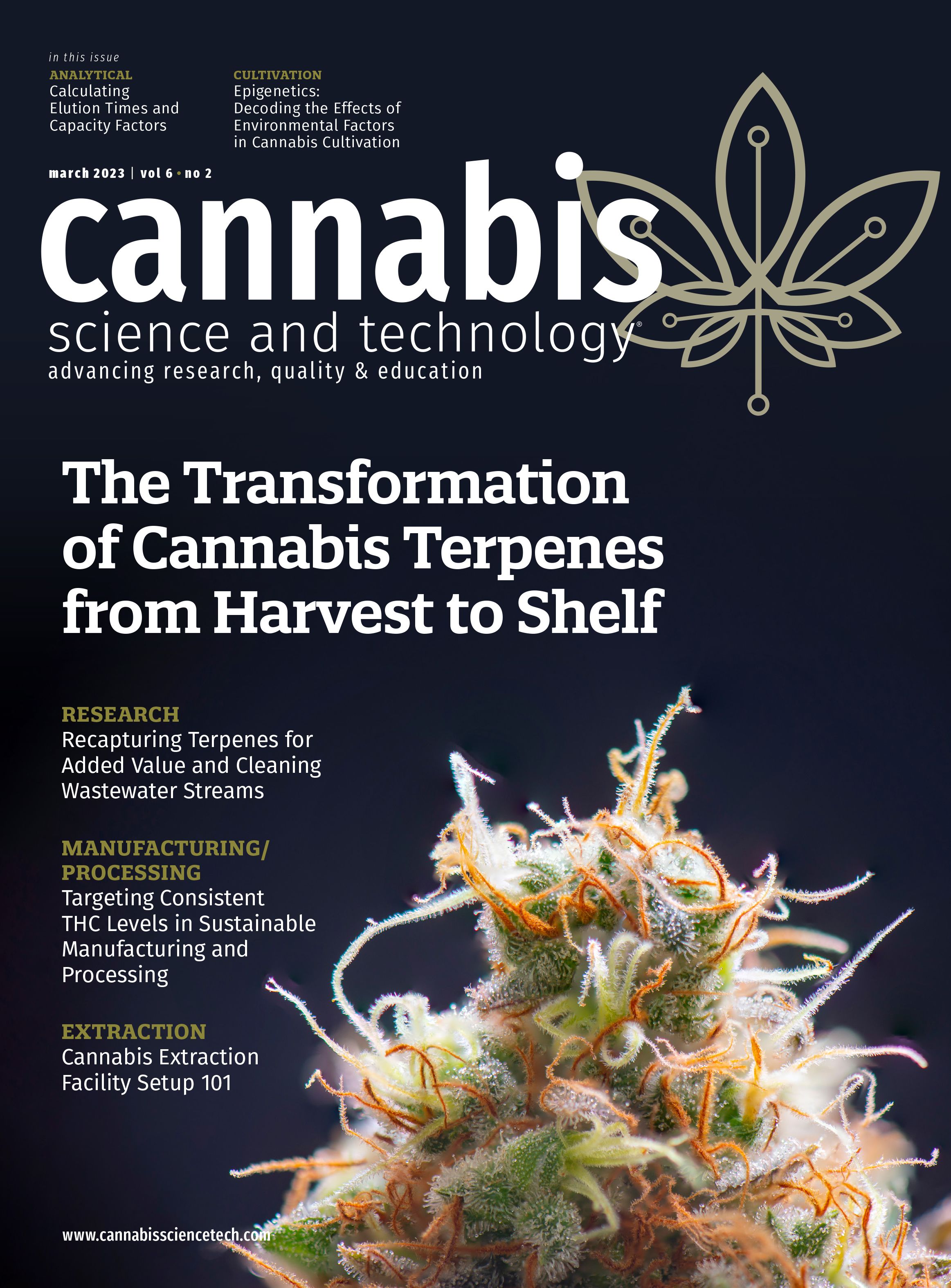Epigenetics: Decoding the Effects of Environmental Factors in Cannabis Cultivation
A look at what epigenetics means, how other plant industries have used or studied them, and how that can be applied to cannabis to improve yields, plant genetics, and solve plant illness.
Want to join the conversation on cannabis cultivation? Register today to attend Cannabis Science Conference April 19-21, 2023 in Portland, Oregon! Join cultivation track program chair Dr. Hildenbrand and see what's new in the industry.
Cannabis, much like any other plant, is susceptible to changes incurred by the surrounding environment. When it comes to cultivation, the peripheral environment is unquestionably critical, with factors such as soil, water, nutrients, and lighting quality and quantity, collectively having a profound impact on the terminal yield and phytochemical profile (cannabinoids, terpenes, and flavonoids) of a resulting crop. Additionally, the sensitivity of individual cultivars to unpredictable environment stressors (for example, pests and microbes) can also alter their phytochemical expression in ways that we don’t fully understand yet. As such, there is a tremendous impetus for the cannabis industry to continue studying the interplay between phytochemical content and environmental factors, which will undoubtedly require us to wade into the relatively unchartered waters of cannabis epigenetics.
In the realm of biochemical research, epigenetics is an aspect of gene regulation that has garnered considerable interest over the past decade. In essence, epigenetics is the study of how environmental factors can alter genetic material, thus influencing the expression of genetic traits. Contrary to genetic mutations, whereby individual changes are made in the nucleotide sequences of deoxyribonucleic acid (DNA), epigenomic modifications do not directly affect these building blocks, and therefore do not result in permanent changes to an organism’s genetic code. Epigenetic modifications occur through DNA methylation, a process involving the transfer of a methyl group (CH3-) onto DNA nucleotides, which can also be mediated (methyl groups removed) by enzymes called DNA demethylases. Collectively, these epigenetic modifications affect how DNA strands interact with histone proteins that are involved in DNA storage and regulation, thus ultimately serving as molecular ON/OFF switches modulating gene expression.
Arguably the most interesting aspect of epigenetic modifications to one’s genetic code is the discovery that these changes can be passed down to subsequent generations. For example, recent studies have now shown that smoking tobacco can have a distinguishable effect on the individual who is smoking (nothing new there), in addition to altering gene expression in their gametes (sperm or egg cells), and gene expression in the gametes of their offspring. This is to say that the genotype/phenotype of a grandchild can be heavily influenced by the environmental conditions experienced by their parents and even grandparents.
Epigenetic Studies in Other Plants
The study of epigenetics likely hasn’t started or hit its full stride in the cannabis industry; primarily due to the federal regulations on cannabis-related research. However, we can learn from the seminal work that has been done in other plants. For example, there is growing evidence that epigenetic regulators play critical roles in fruit development and ripening in flowering plants, and that these molecular actuators might work together with hormones and transcription factors. One example of this is in the way that climacteric fruits (such as tomatoes and bananas) ripen through respiration and ethylene production. Epigenetic modifications have been found to play a role in this process. A distinct example of this is the tomato variant Colorless Non-Ripe (CNR), which exhibits an inhibition of fruit softening and the absence of carotenoid and flavor compound accumulation. Studies have shown that the CNR variant arises from the hypermethylation of a 286 bp region that is located 2.4 kb upstream of a SQUAMOSA promoter binding protein-like transcription factor (SBP box/SPL). In result, this leads to a spontaneous mutation known as CNR. The CNR mutant is characterized by a non-ripening phenotype where the fruits turn white and then yellow but remain firm during the ripening period. This study supports the notion that natural methylation polymorphisms can influence the fruit phenotype of tomato plants under specified environmental conditions, demonstrating the importance of epigenetic variation in tomato plants (1).
As it turns out, the ripening of orange fruits is also attributable to hypermethylation. This involved the active expression of several hundreds of genes including genes involved in abscisic acid, a prominent plant hormone responsible for a myriad of physiological processes (2). These findings demonstrate that epigenetic modifications play an integral role in orange fruit ripening during early stages of plant development.
Additionally, natural variation in vitamin E concentrations found in tomato fruits has also been associated with changes in DNA methylation at the promoter of the enzyme 2-methyl-6-phytylquinol methyltransferase (1). As such, it is clear that epigenetic processes play critical roles in a number of physiological, metabolic, and molecular changes in fruit-bearing plants, the extent of which remains to be determined. However, it is plausible that the interplay between DNA methylation and demethylation has a discernible role in the relative expression of pigmentation, soluble sugars, and aromatic volatile compounds. It is technical findings such as these that could yield “fruitful” results in the cannabis industry.
Applications in the Cannabis Industry
In cannabis (Groups I, II, and III), understanding the genetics and what phytochemical contents are influenced by the environment is crucial to the expression of various phenotypes in a genetic cultivar. As such, the use of epigenetic analyses in the cannabis industry could help us differentiate chemical characteristics that are predominantly genetic-based from those that may be attributable to the cultivation environment. Ultimately, this would allow us to “dial in” the cultivation variables for a certain genetic so that it yields a precise phytochemical profile for the treatment of specific ailments.
While the production of phytochemical content and yields in cannabis depends on a number of environmental factors (soil, water, nutrients, and so forth) lighting is unequivocally the most influential variable. During photosynthesis, light can provide energy to the plant, but also act as a sensory signal that affects growth and development, physiological functions, and biochemical pathways. Various studies have begun exploiting the spectral flexibility of light emitting diodes (LEDs) to examine the effect of different spectral combinations on cannabis production and phytochemical diversity under in controlled environment agriculture (3-4).
With that being said, experimenting with different lighting spectra and intensities seems like the most fertile ground for epigenetic studies in the cannabis industry to better understand the interplay between horticultural lighting and cannabinoid, terpene, and flavonoid expression, particularly for any downstream clones or offspring (seeds) (see Figure 1).
For example, we may discover that how you treat your seeds and mother plants can have a noticeable effect on multiple subsequent generations. Hypothetically speaking, if you “pop” seeds under a T4 bulb and then switch them over to a full-spectrum LED to be “mothered” for clones, it is possible that the lack of full spectrum photons (400–700 nm) from the T4 could have downstream implications for the subsequent clones or even any pollen or seeds that those clones may produce. We already know that cannabis can experience “spectral shock” if the spectral changes between two points in the cultivation cycle are too drastic. This is primarily an issue going from the sparce spectrum of a T4 bulb in cloning to a full spectrum light in veg. You’ll notice that for the first 7-10 days of this switch, the plants will appear as though they are struggling to thrive, or potentially “burning up” completely. As such, it seems completely plausible that if these effects are noticeable in the current generation then this change in environmental stimuli could have significant downstream implications. While this phenomenon is poorly understood, propagating clones from tissue culture may be one way to address the accumulation of poor treatment or “epigenetic baggage.”

Conclusions
Across the past decade there has been an explosion of new knowledge with respect to how to improve cannabis production. This is largely the result of new research designed to further elucidate the interplay between phytochemical expression and the quality of the surrounding environment. However, how do environmental factors, such as lighting, affect the chemical composition of downstream products? It is still unclear how epigenetic inheritance works in cannabis and how epigenetics contributes to the phenomenon of nature versus nurture. Although this research is still in its infancy, it has been established that DNA methylation/demethylation is another layer through which the genome’s language is interpreted and, ultimately, demonstrated in an organism’s phenotype. As such, it is going to be extremely exciting to see how all of this unfolds in the cannabis industry for years to come. The hope is that a better understanding of the cannabis epigenome will provide cultivation experts with another opportunity to produce highly efficacious products that can be tailor-made for the effective treatment of specific ailments.
References
- Gallusci, P., Hodgman, C., Teyssier, E., and Seymour, G. B., DNA Methylation and Chromatin Regulation during Fleshy Fruit Development and Ripening, Frontiers in Plant Science, 2016, 7, 807.
- Huang, H., Liu, R., Niu, Q., Tang, K., Zhang, B., Zhang, H., Chen, K., Zhu, J. K., and Lang, Z., Global increase in DNA methylation during orange fruit development and ripening, Proceedings of the National Academy of Sciences of the United States of America, 2019, 116 (4), 1430–1436.
- Hildenbrand, Z.L., Liden, T., Jacques, A., Spurlock, M., West, C., Westerfield, R.E., and Schug, K.A., Differentiation of Group III cannabis into distinct sub-classes. Cannabis Science and Technology, 2021, 4 (9), 32-37.
- Hildenbrand, Z.L., Grosella, A., Manes, R.J., Spurlock, M., Jacques, A., West, C., Love, O.R., Westerfield, R.E., Pecore, M., Liden, T., Gao, S. and Schug, K.A., Variable red light exposure affects phytochemical content in Group III cannabis cultivars, Cannabis Science and Technology, 2022, 5 (6), 30-42.
About the Columnist

Dr. Zacariah Hildenbrand is a research Professor at the University of Texas at El Paso, the principal founder of Inform Environmental, a partner of Medusa Analytical, and is a director of the Curtis Mathes Corporation (OTC:CMCZ). Direct correspondence to: zlhildenbrand@utep.edu.
About the Guest Co-Author

Hannia Mendoza is an MS Chemistry student at The University of Texas at El Paso.
How to Cite this Article:
Mendoza, H., Hildenbrand, Z., Epigenetics: Decoding the Effects of Environmental Factors in Cannabis Cultivation, Cannabis Science and Technology, 2023, 6(2), 18-21.

Cannabis Pricing Crisis: Market Forces Shaping 2025 Trends
June 30th 2025The volatility of wholesale cannabis prices marked by large fluctuations and regional disparities highlight the inherent instability still present in the cannabis marketplace. Adapting to shrinking margins and increased competitions is putting pressure on operators, causing them to adopt cost-cutting technologies, expand into edibles and extracts, and secure long-term supply agreements. Understanding these evolving dynamics is essential for companies to adapt, compete, and thrive in the industry.
Best of the Week: June 13 – June 19, 2025
June 20th 2025Here, we bring you our top five recent articles covering medical cannabis in Hawaii, a new dispensary in Connecticut, pesticide testing in California, a cease-and-desist letter to a dispensary on Long Island, and a global survey on cannabis for endometriosis.